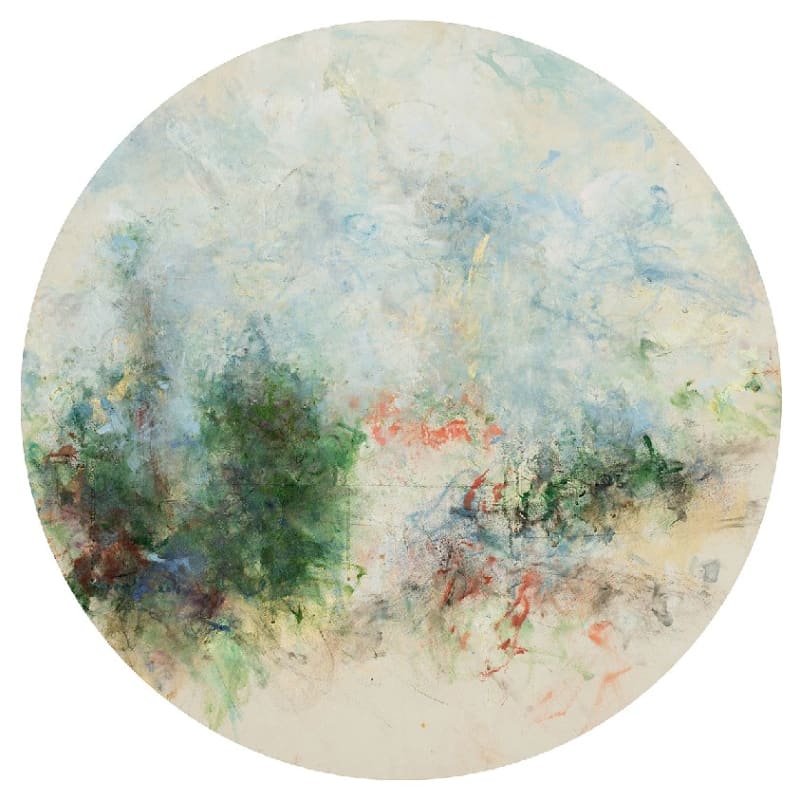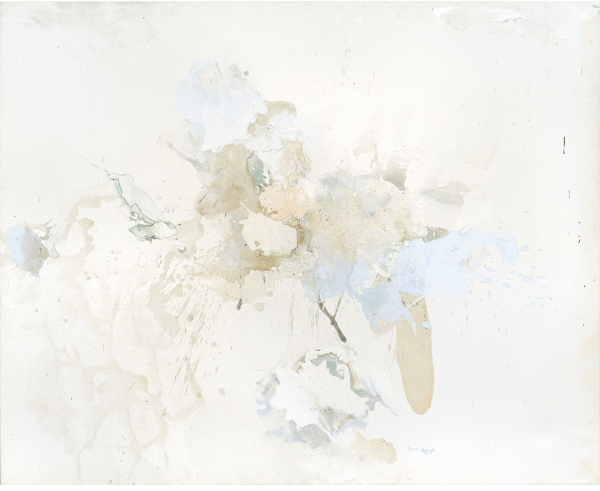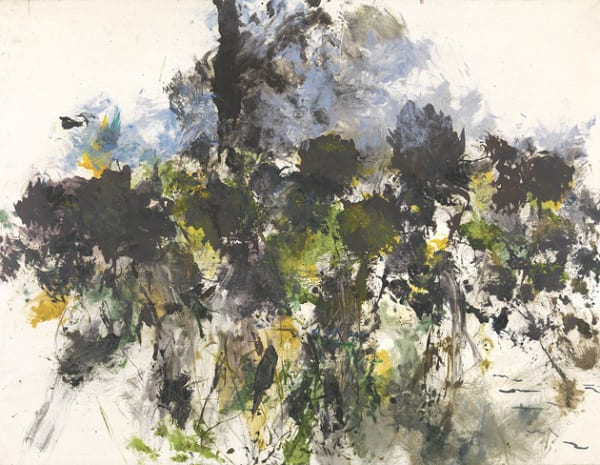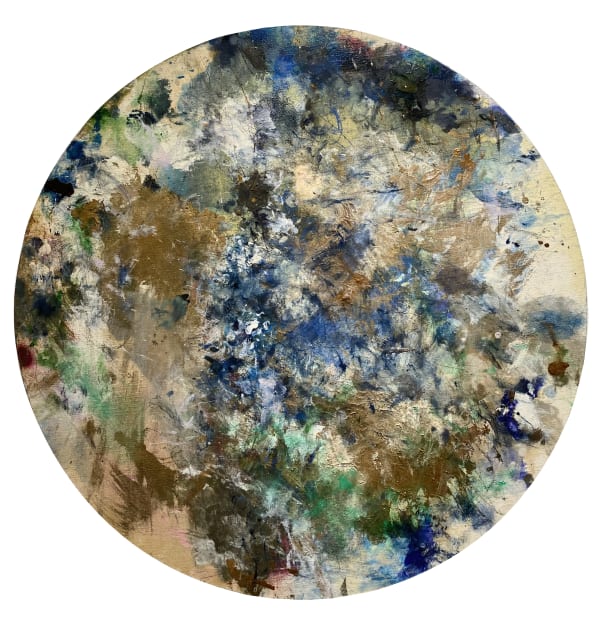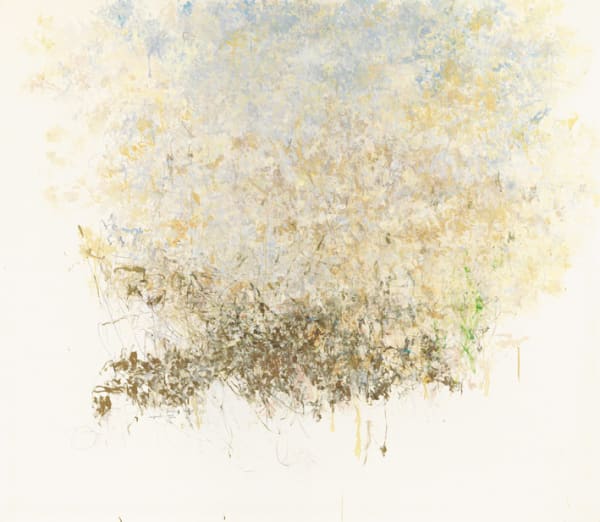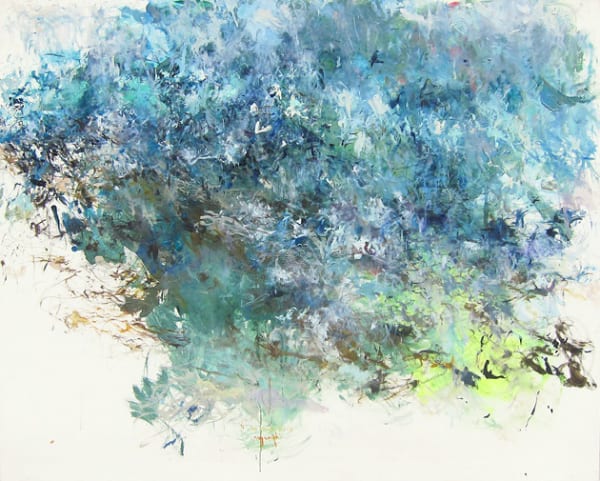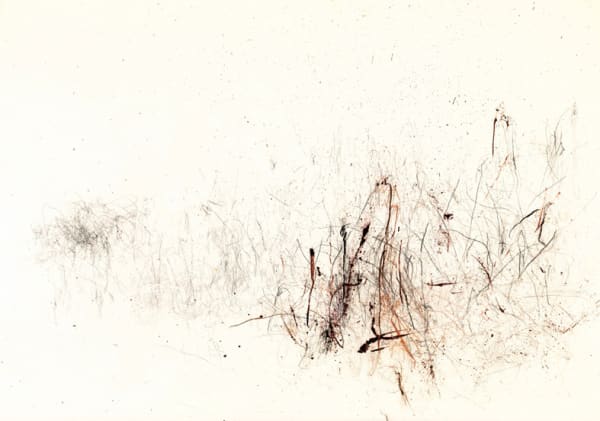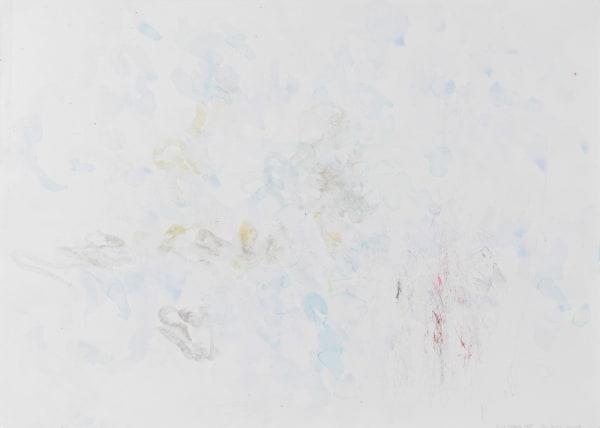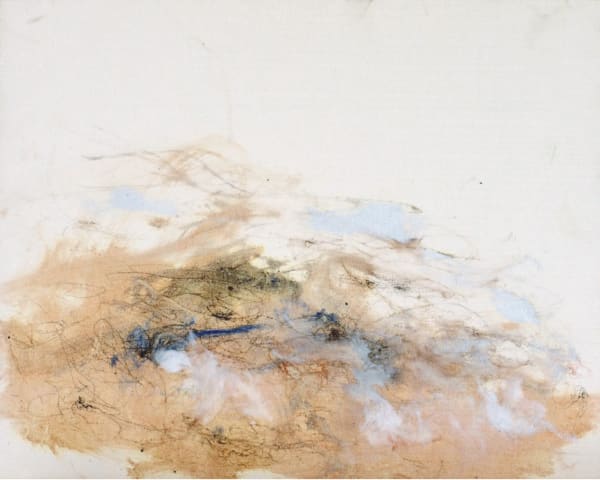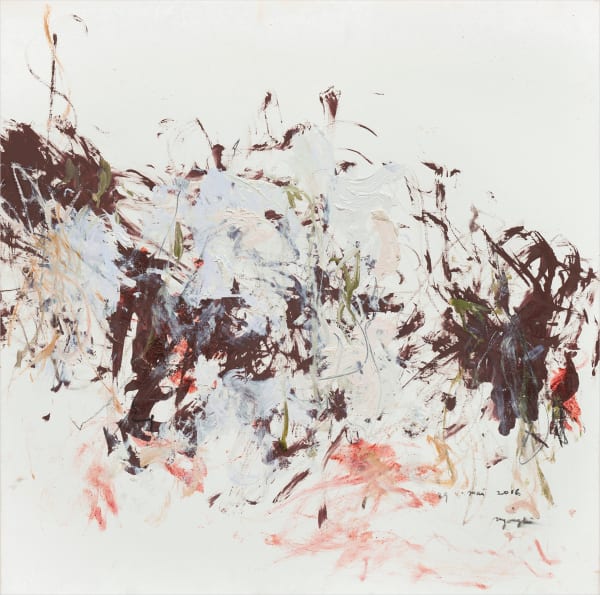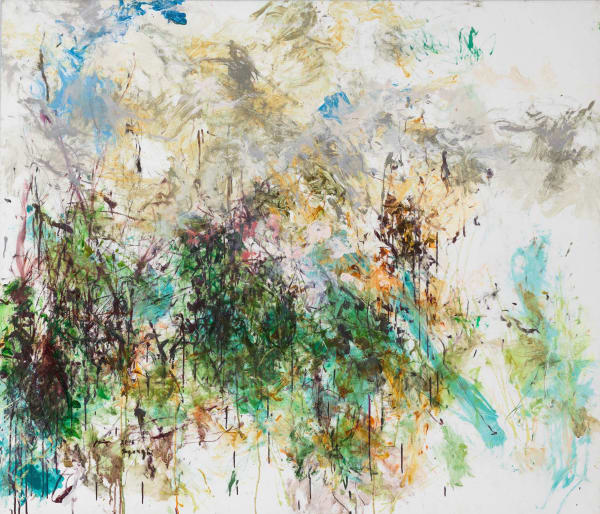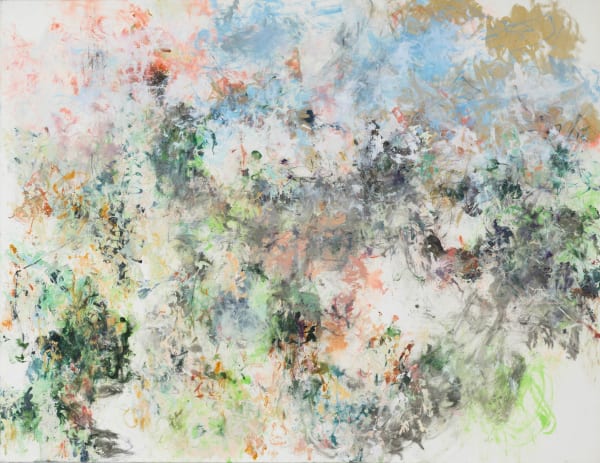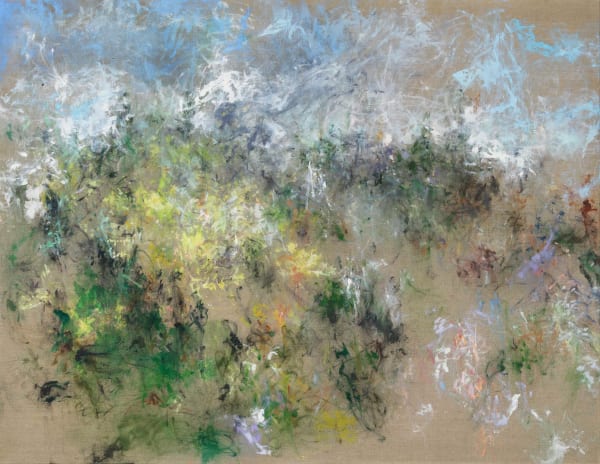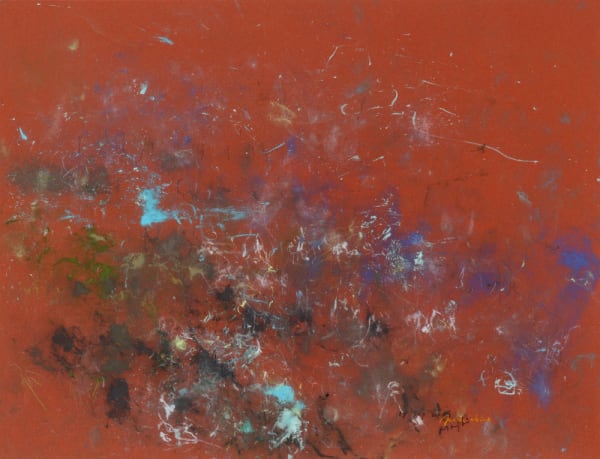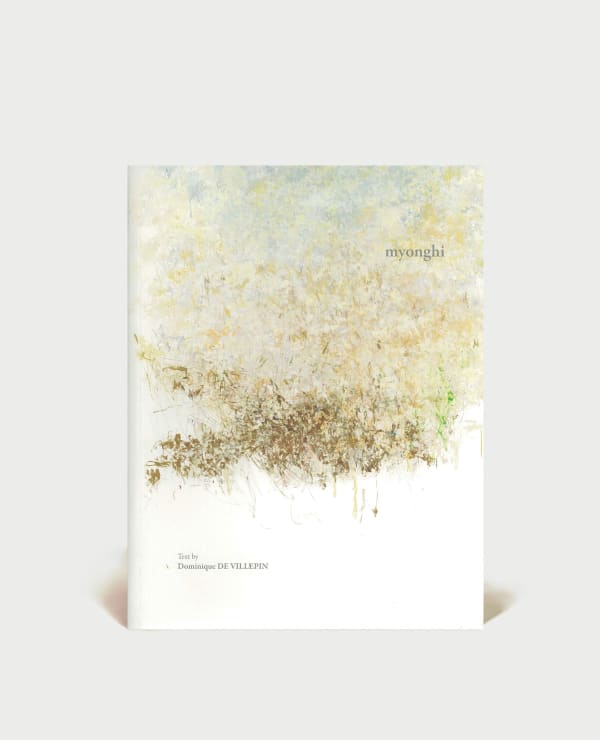Myonghi 明 姬 b. 1947
Born in 1947 in Daegu, South Korea, Myonghi immigrated to France in 1972. Today, she splits her time between the two countries. Apart from some exhibitions at museums and poem parties, where she worked with various writers on pairing their poems with her paintings, Myonghi has lived a quiet life, focused purely on her artwork. Nevertheless, over the years she has gained much recognition and respect from academic circles, including philosopher Philippe Lacoue-Labarthe and poet Alain Jouffroy. Mr. Dominique de Villepin, the former Prime Minister of France, is also a poet and an art critic with a wide knowledge and appreciation for abstract art. He is full of praise for Myonghi as an artist, and describes her as "a gem known only to insiders".
Myonghi has travelled throughout the globe, from the Gobi Desert to the Patagonia Glaciers, in order to sketch and find inspiration. While she selects her subjects from nature, she endeavours to explore a realm beyond pictorial structures and exterior appearance. Keen to discover the inner nature of her subject and to identify its core, Myonghi is in a way exploring hidden dimensions within nature, and the results of her findings are a marvel to behold.
The paintings of Myonghi have been exhibited in important museums including National Museum of Contemporary Art (South Korea), Centre Georges Pompidou (Paris, France), National Art Museum of China (Beijing, China) and Shanghai Art Museum (China).
-
 Black Sunflower I《黑向日葵之一》, 2001
Black Sunflower I《黑向日葵之一》, 2001 -
 Scabiense《藍盆花》, 2001
Scabiense《藍盆花》, 2001 -
 Star《星星》, 2004
Star《星星》, 2004 -
 Andeok Valley《安德溪谷》, 2007
Andeok Valley《安德溪谷》, 2007 -
 Andeok Valley 1《安德溪谷1》, 2007-2008
Andeok Valley 1《安德溪谷1》, 2007-2008 -
 Star I《星之一》, 2008
Star I《星之一》, 2008 -
 North Garden《北園》, 2008-2010
North Garden《北園》, 2008-2010 -
 Touraine 《都蘭, 法國》, 2010
Touraine 《都蘭, 法國》, 2010 -
 Black Sunflower II 《黑向日葵之二》, 2011
Black Sunflower II 《黑向日葵之二》, 2011 -
 Monsilang《楝樹》, 2011
Monsilang《楝樹》, 2011 -
 Hwangwouchi《黃牛峙》, 2011
Hwangwouchi《黃牛峙》, 2011 -
 Hwangwouchi《黃牛峙》, 2011
Hwangwouchi《黃牛峙》, 2011 -
 Shrine of the Wandering 6 《失者的聖地 6》, 2012
Shrine of the Wandering 6 《失者的聖地 6》, 2012 -
 Shrine of the Wandering 1 《迷失者的聖地1》, 2012
Shrine of the Wandering 1 《迷失者的聖地1》, 2012 -
 Orange Grove《柑橘園》, 2012
Orange Grove《柑橘園》, 2012 -
 Shrine of the Wandering 4 《迷失者的聖地 4》, 2012
Shrine of the Wandering 4 《迷失者的聖地 4》, 2012 -
 Shrine of the Wandering - Dance of General Pei Min《迷失者的聖地, 裴旼之舞》, 2012
Shrine of the Wandering - Dance of General Pei Min《迷失者的聖地, 裴旼之舞》, 2012 -
 Shrine of the Wandering 6 《失者的聖地 6》, 2012
Shrine of the Wandering 6 《失者的聖地 6》, 2012 -
 Village《村莊》, 2012-2014
Village《村莊》, 2012-2014 -
 Nonjitmoul《諾基姆》, 2013
Nonjitmoul《諾基姆》, 2013 -
 Nonjitmoul III 《諾基姆之三》, 2013
Nonjitmoul III 《諾基姆之三》, 2013 -
 Nonjitmoul I 《諾基姆之一》, 2013
Nonjitmoul I 《諾基姆之一》, 2013 -
 Grass, Nonjitmoul 4 《草, 諾基姆 4》, 2013
Grass, Nonjitmoul 4 《草, 諾基姆 4》, 2013 -
 Grass, Nonjitmoul 1 《草, 諾基姆 1》, 2013
Grass, Nonjitmoul 1 《草, 諾基姆 1》, 2013 -
 North-East Pacific《東北太平洋》, 2013
North-East Pacific《東北太平洋》, 2013 -
 Grass, Daepyeong 2《草, 大坪 2》, 2013
Grass, Daepyeong 2《草, 大坪 2》, 2013 -
 Sky of Keumneung《金陵的天空》, 2013
Sky of Keumneung《金陵的天空》, 2013 -
 The Medici Fountain 10 《梅迪奇噴泉10》, 2013
The Medici Fountain 10 《梅迪奇噴泉10》, 2013 -
 Keumneung 5《金陵 5》, 2013
Keumneung 5《金陵 5》, 2013 -
 Untitled《無題》, 2013
Untitled《無題》, 2013 -
 Nonjitmoul III 《諾基姆之三》, 2013
Nonjitmoul III 《諾基姆之三》, 2013 -
 Nonjitmoul I 《諾基姆之一》, 2013
Nonjitmoul I 《諾基姆之一》, 2013 -
 Kaki II《柿子之二》, 2014
Kaki II《柿子之二》, 2014 -
 The Medici Fountain 4《梅迪奇噴泉4》, 2014
The Medici Fountain 4《梅迪奇噴泉4》, 2014 -
 The Medici Fountain 10《梅迪奇噴泉10》, 2014
The Medici Fountain 10《梅迪奇噴泉10》, 2014 -
 The Medici Fountain 3《梅迪奇噴泉 3》, 2014
The Medici Fountain 3《梅迪奇噴泉 3》, 2014 -
 Seogwang Studio, Pine《西廣畫室,松樹》, 2014-2016
Seogwang Studio, Pine《西廣畫室,松樹》, 2014-2016 -
 Medici Fountain I 《梅迪奇噴泉之一》, 2015
Medici Fountain I 《梅迪奇噴泉之一》, 2015 -
 Village Seo Kwang 《西廣東里》, 2015
Village Seo Kwang 《西廣東里》, 2015 -
 The Medici Fountain 5《梅迪奇噴泉5》, 2015
The Medici Fountain 5《梅迪奇噴泉5》, 2015 -
 Visitation 4 《探視 4》, 2015-2016
Visitation 4 《探視 4》, 2015-2016 -
 Seogwang Studio, The Roof 《西廣畫室,屋頂》, 2015-2016
Seogwang Studio, The Roof 《西廣畫室,屋頂》, 2015-2016 -
 Peony 2《牡丹 2》, 2016
Peony 2《牡丹 2》, 2016 -
 The Courtyard E 《庭院 E》, 2016
The Courtyard E 《庭院 E》, 2016 -
 Seokwang Village, April《西廣村莊,四月》, 2016
Seokwang Village, April《西廣村莊,四月》, 2016 -
 North Garden, November《北園,十一月》, 2016
North Garden, November《北園,十一月》, 2016 -
 Hong Kong, Stream 1 《香港, 川流 1》, 2016
Hong Kong, Stream 1 《香港, 川流 1》, 2016 -
 Hong Kong, Stream 2《香港, 川流 2》, 2016
Hong Kong, Stream 2《香港, 川流 2》, 2016 -
 Peony 1《牡丹 1》, 2016
Peony 1《牡丹 1》, 2016 -
 Seogwang Studio, Mid August《西廣畫室,八月中旬》, 2016
Seogwang Studio, Mid August《西廣畫室,八月中旬》, 2016 -
 Seogwng Studio, Mid July《西廣畫室,七月中旬》, 2016
Seogwng Studio, Mid July《西廣畫室,七月中旬》, 2016 -
 Seokwang, Winter《西廣,冬》, 2017
Seokwang, Winter《西廣,冬》, 2017 -
 Seokwang Village, Autumn《西廣村莊,秋》, 2017
Seokwang Village, Autumn《西廣村莊,秋》, 2017 -
 Seokwang, Pine Fields《西廣,松林》, 2017
Seokwang, Pine Fields《西廣,松林》, 2017 -
 Hwangwoochi 2《黃牛峙 2》, 2017
Hwangwoochi 2《黃牛峙 2》, 2017 -
 Seokwang Village, Spring 《西廣村莊,春》, 2017
Seokwang Village, Spring 《西廣村莊,春》, 2017 -
 Seokwang, Path《西廣,小道》, 2017
Seokwang, Path《西廣,小道》, 2017 -
 Eongal, Black Sand《岳卵,黑沙》, 2017
Eongal, Black Sand《岳卵,黑沙》, 2017 -
 Sanyang Forest《山陽森林》, 2017
Sanyang Forest《山陽森林》, 2017 -
 Eongal, Coast 1《岳卵,海岸 1》, 2017
Eongal, Coast 1《岳卵,海岸 1》, 2017 -
 Keumneung 9《金陵 9》, 2017
Keumneung 9《金陵 9》, 2017 -
 Eongal, Coast 2《岳卵,海岸 2》, 2017
Eongal, Coast 2《岳卵,海岸 2》, 2017 -
 Hong Kong, Stream 4《香港, 川流 4》, 2017
Hong Kong, Stream 4《香港, 川流 4》, 2017 -
 Hong Kong, Stream 5《香港, 川流 5》, 2017
Hong Kong, Stream 5《香港, 川流 5》, 2017 -
 Pine Fields, Air of Wang Meng《王蒙氣韻》, 2017-2018
Pine Fields, Air of Wang Meng《王蒙氣韻》, 2017-2018 -
 Seokwang Village《西廣村莊》, 2017-2018
Seokwang Village《西廣村莊》, 2017-2018 -
 The Time of Camellias《冬柏之時》, 2018
The Time of Camellias《冬柏之時》, 2018 -
 Seokwang Village 2《西廣村莊 2》, 2018
Seokwang Village 2《西廣村莊 2》, 2018 -
 Camellia《冬柏》, 2018
Camellia《冬柏》, 2018 -
 The Optician's Home I 《眼鏡師的房子之一》, 2019
The Optician's Home I 《眼鏡師的房子之一》, 2019 -
 Slope III《坡之三》, 2020
Slope III《坡之三》, 2020
Myonghi selects painting objects from nature and presents a world that is captured by her unique sensibility, in abstract strokes of strong personal character.
Myonghi paints in a way similar to poetry writing. Whether by way of a big size oil painting or a simple drawing on paper, her works are serious and solid in structure, with all excess details trimmed off. None of her strokes are unnecessary.
The work Village depicts a vista view from Andeok Valley to Daepyeong in Jeju. On the painting are just layers of small irregular patches and outlines of different colors, which are crossing and interlacing with each other, but do not create any recognizable objects. The margins at the bottom and on both sides of this two-meter work are left blank, so that the semi-oval main body looks like it is hanging upside down in the air. At its lower part, a thick pile of golden fragments are trembling, which must be the reflection of sunshine splashing on a close bush. In the middle, there are thick and thin, large and small, curvy and convoluted patches of light yellow, light beige, light green and light blue. Is it not a faraway forest resting in the breeze, with footprints and stories hidden in it? On the top, the boundless sky emerges in the form of rolling light blue and white beads. This is a landscape stretching from close to far, in a delicately knit structure. Both impressionist and abstract styles are applied, in accordance with the natural flow of the pictorial composition, and they are integrated with each other seamlessly.
According to Mr. Dominique de Villepin,
"Her art becomes a link between the East and the West. But it is not a one way link, on the contrary it is a path one can take in every direction and a place where the aspirations of the East and of the West can meet, but where can also interlink other meetings, other inspirations, other civilizations. Myonghi opens doors that nobody had guessed were there…
She started with Western art, as the witness of a generation with worldwide horizons. She came back later on but without any disowning and without any conversion to any teachings, both philosophical and technical of Eastern painting. This path towards the past can be seen in the modifications of the paintings, in a new dialectic of the sign and of the color. Some similarities can be found, with the difference of one generation, between the path of a Zao Wou-ki trained to European modern art during his youth before discovering his own artistic identity and Myonghi's progression, between the poles of Korea and Touraine…
Myonghi's paintings…are alive. They are out of time. They are absolutely present. They are efficient, which means that they influence those who look at them…They radiate the power of joy that made them arise, this bliss of the painting that so few artists are able to capture, live and return and that Myonghi has been endowed with, as it has for example been the case for Zao Wou-ki…
She is one of the greatest artists overlapping two centuries and rooted into the worlds. She is one of the voices that count and that will count to bear witness of the modifications of the world and of the new aspirations."
-
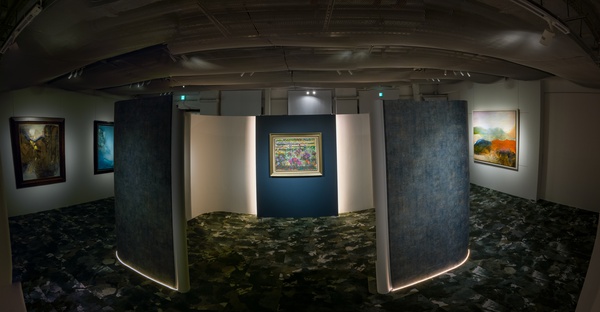
Worlds Beyond Reality - Monet's Legacy
Kwai Fung Hin Art Gallery 4 Jan - 18 Apr 2023Claude Monet and the Impressionists opened a new chapter in art history, leading the way for the continuous expansion of imagination by landscapes artists in...Read more -
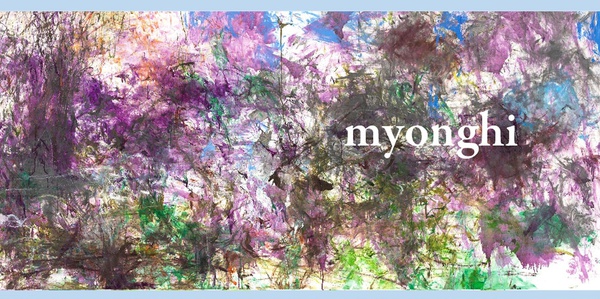
Consciousness of Color, Color of Consciousness - Solo Exhibition of Myonghi
Kwai Fung Hin Art Gallery, G/F, 20 Ice House Street, Central, Hong Kong 15 Oct - 15 Nov 2018Read more -
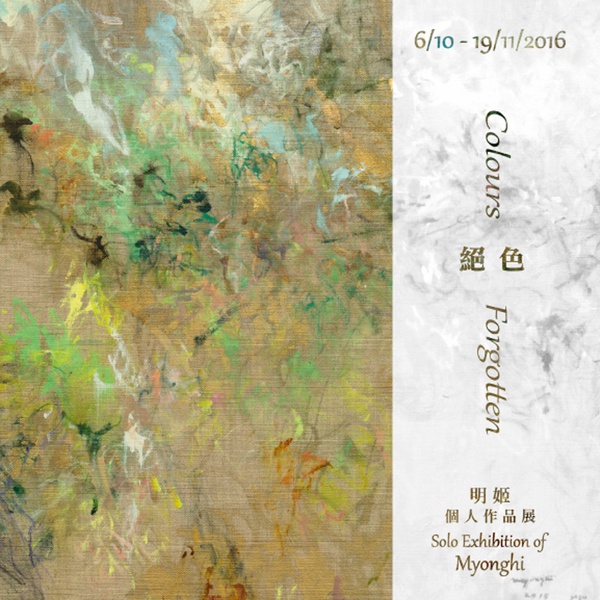
Colours Forgotten - Solo Exhibition of Myonghi
Kwai Fung Hin Art Gallery, G/F, 20 Ice House Street, Central, Hong Kong 6 Oct - 19 Nov 2016Solo Exhibition of Korean painter MyonghiRead more -
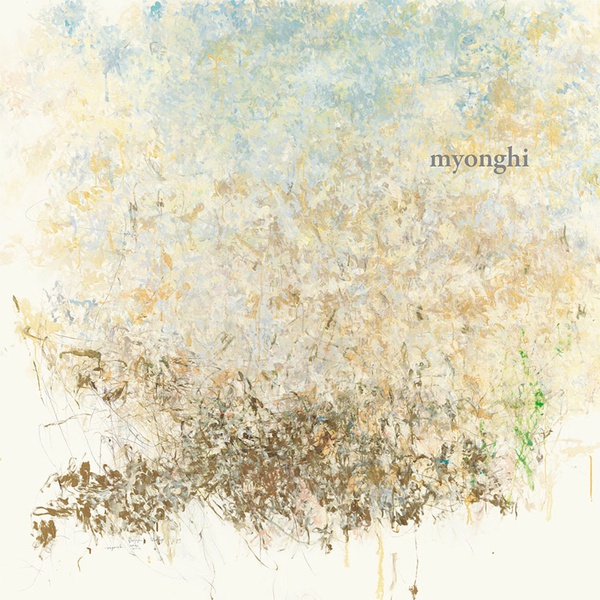
Fleeting Eternities - Recent Works of Myonghi
Kwai Fung Hin Art Gallery, G/F, 20 Ice House Street, Central, Hong Kong 13 Mar - 12 Apr 2015Solo Exhibition of France-based Korean painter MyonghiRead more
